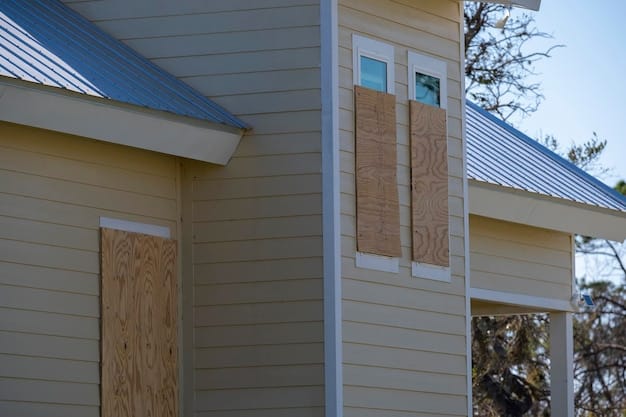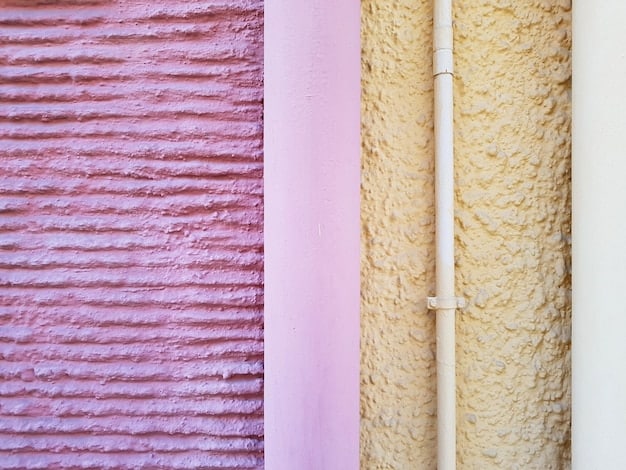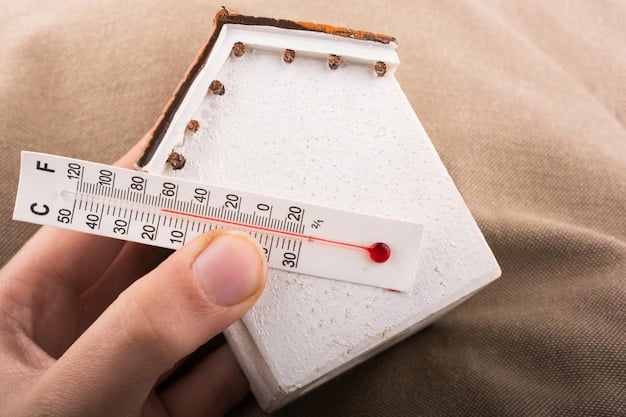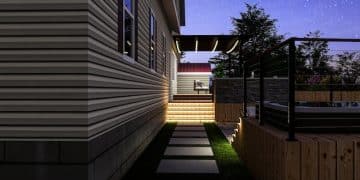The 2025 Home Insulation Guide: Save Money & Stay Cozy

The 2025 Guide to Home Insulation equips homeowners with the latest information on insulation types, R-values, installation best practices, and cost-saving strategies to maximize energy efficiency and maintain year-round comfort while reducing energy bills.
Ready to upgrade your home’s comfort and slash those energy bills? The **2025 Guide to Home Insulation: Save Money and Stay Comfortable Year-Round** is your comprehensive resource for everything you need to know about insulating your home in the coming year.
Understanding Home Insulation: Why It Matters
Home insulation is more than just stuffing material into walls; it’s a critical component of your home’s energy efficiency and indoor comfort. Proper insulation acts as a barrier, preventing heat from escaping in the winter and keeping it out during the summer.

This section will delve into what insulation is, and why it’s so essential for every homeowner in the US.
What is Home Insulation?
Simply put, home insulation is a material designed to reduce the transfer of heat through the walls, roof, and floors of your home. This helps maintain a consistent temperature inside, regardless of the weather outside.
The Benefits of Proper Insulation
Investing in good insulation offers numerous advantages beyond just comfort. It can lead to significant savings on your energy bills and prevent structural integrity issues.
- Reduced Energy Bills: Less reliance on heating and cooling systems.
- Increased Comfort: Eliminates drafts and temperature fluctuations.
- Environmental Impact: Reduces carbon footprint by lowering energy consumption.
- Protection Against Moisture: Prevents condensation and mold growth.
In conclusion, investing in home insulation is a cost-effective way to enhance comfort, save money, and protect your home. By understanding what insulation is and its importance, homeowners can make informed decisions when improving their property.
Types of Home Insulation Materials in 2025
Choosing the correct type of insulation for your home is essential for optimal energy efficiency. The market offers many options, each with distinct properties, benefits, and appropriate applications.
Let’s explore the most common types of home insulation materials available in 2025.
Fiberglass Insulation
Fiberglass is one of the most widely used insulation materials, known for its affordability and ease of installation. It comes in batts, rolls, and loose-fill forms.
Cellulose Insulation
Cellulose insulation is made from recycled paper products, making it an eco-friendly option. It is typically installed as loose-fill insulation in attics and walls.
Spray Foam Insulation
Spray foam insulation is a popular choice for its excellent air-sealing properties. It expands to fill gaps and cracks, providing a tight thermal barrier.
- Open-Cell Foam: More affordable, flexible, and allows for some moisture permeability.
- Closed-Cell Foam: Higher R-value, waterproof, and adds structural integrity.
- Mineral Wool: Fire-resistant and effective for soundproofing.
Selecting the right insulation material involves considering factors such as your budget, climate, and specific insulation needs. By understanding the pros and cons of each type, homeowners can make an informed choice that best suits their home.
Understanding R-Values: What You Need to Know
R-value is a term frequently encountered when discussing home insulation. Understanding what it means and how it affects your insulation choices is crucial for making informed decisions.
This section will break down the R-value concept, explaining its significance in home insulation.
What is an R-Value?
An R-value measures thermal resistance, or how well insulation resists the flow of heat. The higher the R-value, the better the insulation’s ability to reduce heat transfer.
Recommended R-Values by Region
The appropriate R-value for your home depends on the climate in your geographic location. Here’s a general guide:
Factors Affecting R-Value
Several factors can affect the actual R-value of installed insulation:
- Material Thickness: Thicker insulation generally provides a higher R-value.
- Proper Installation: Gaps or compression can reduce effectiveness.
- Material Density: Denser materials often have improved thermal resistance.

Understanding R-values is essential for optimizing your home’s insulation. By considering climate zones, consulting local building codes, and ensuring proper installation, homeowners can achieve the best insulation performance for their needs.
DIY vs. Professional Insulation Installation
One significant decision when upgrading your home insulation is whether to tackle the installation yourself or hire a professional. Both options have their merits and drawbacks.
Here, we will explore the pros and cons of DIY versus professional installation to help you decide which method is best for your situation.
DIY Insulation Installation
DIY insulation can be a cost-effective option for homeowners willing to undertake the project themselves. It is particularly suitable for straightforward tasks such as insulating attics or crawl spaces.
Hiring a Professional Insulation Contractor
Hiring a professional insulation contractor ensures the job is done correctly and efficiently. Professional installers have the experience, tools, and knowledge to handle complex insulation projects.
- Expertise: Proper installation techniques and knowledge of building codes.
- Equipment: Access to specialized equipment like spray foam applicators.
- Safety: Experience handling materials safely.
- Warranty: Assurance of quality workmanship.
The decision between DIY and professional insulation installation depends on your comfort level, budget, and the complexity of the project. Assessing the pros and cons of each approach ensures homeowners make the best choice for their home insulation needs.
Cost Considerations and Potential Savings
Investing in home insulation involves up-front costs, but it can lead to significant long-term savings. Understanding the potential costs and savings associated with insulation is crucial when planning your project.
This section will break down the financial aspects of home insulation, highlighting the benefits and potential return on investment.
Initial Costs of Insulation
The initial costs of insulation vary depending on the type of material, the area to be insulated, and whether you choose DIY or professional installation.
Long-Term Energy Savings
The primary benefit of proper insulation is the reduction in energy consumption. By minimizing heat transfer, you’ll use less energy. This lower energy usage results in monthly savings on your utility bills.
Government Incentives and Rebates
Many government programs offer incentives and rebates for homeowners who invest in energy-efficient upgrades, including insulation. You should investigate the availability of these programs in your area.
- Federal Tax Credits: Offers tax credits for energy-efficient home improvements.
- State and Local Rebates: Provides rebates for specific insulation materials.
- Utility Company Programs: Offers incentives for reducing energy consumption.
Proper insulation can save a significant amount of money over time, making it a wise home investment. By considering initial costs, long-term energy savings, and available incentives, homeowners can make informed decisions that balance expense and benefit.
Maintaining Your Insulation for Longevity
Once your insulation is installed, proper maintenance is essential to ensure it performs optimally and lasts for years to come. Regular inspections and timely repairs can prevent common issues and prolong the lifespan of your insulation.
In this section, we’ll cover key maintenance practices and strategies for keeping your insulation in top condition.
Regular Inspections
Conducting regular inspections allows you to identify potential issues early. Check for signs of damage or wear, such as:
Preventing Moisture Problems
Moisture is a significant threat to insulation, as it can reduce its effectiveness and promote mold growth. To prevent moisture problems, ensure proper ventilation in your home and address any leaks promptly.
Pest Control Measures
Pests, such as rodents and insects, can damage insulation by nesting in it or using it as a food source. Implement pest control measures to protect your insulation and maintain its integrity.
- Seal Entry Points: Seal cracks and openings to prevent pests from entering.
- Use Pest-Resistant Materials: Consider insulation materials that are less attractive to pests.
- Regular Pest Control: Engage a professional pest control service if necessary.
By conducting regular inspections, preventing moisture problems, and implementing pest control measures, homeowners can maintain their insulation and extend its life. These practices ensure that your insulation investment continues to provide energy efficiency and comfort for years to come.
| Key Point | Brief Description |
|---|---|
| 🏠 Importance of Insulation | Saves energy, enhances comfort, and protects home structure. |
| 🌡️ Understanding R-Values | Measures insulation effectiveness; higher R-value means better insulation. |
| 💰 Cost vs. Savings | Initial investment pays off with long-term energy savings and incentives. |
| 🛠️ DIY or Professional | Choose based on project complexity and your expertise. |
Frequently Asked Questions
▼
The most common types include fiberglass, cellulose, spray foam, and mineral wool, each offering different R-values and suitability for various areas of your home.
▼
Refer to the Department of Energy’s guidelines; R-values vary based on climate zone. Local building codes also provide specific recommendations for your area.
▼
DIY can save money on simple tasks, but professional installation ensures proper techniques are used, especially for complex jobs like spray foam.
▼
Yes, many federal, state, and local programs offer tax credits and rebates for energy-efficient home improvements, incentivizing insulation upgrades.
▼
Regular inspections for moisture and pests, sealing entry points, and ensuring proper ventilation are critical for maintaining your insulation’s effectiveness.
Conclusion
As you prepare your home for 2025, remember that the **2025 Guide to Home Insulation: Save Money and Stay Comfortable Year-Round** offers a roadmap to energy efficiency and enhanced comfort. By understanding the types of insulation, R-values, and installation methods, you can make informed decisions that save you money and create a more sustainable living environment.





